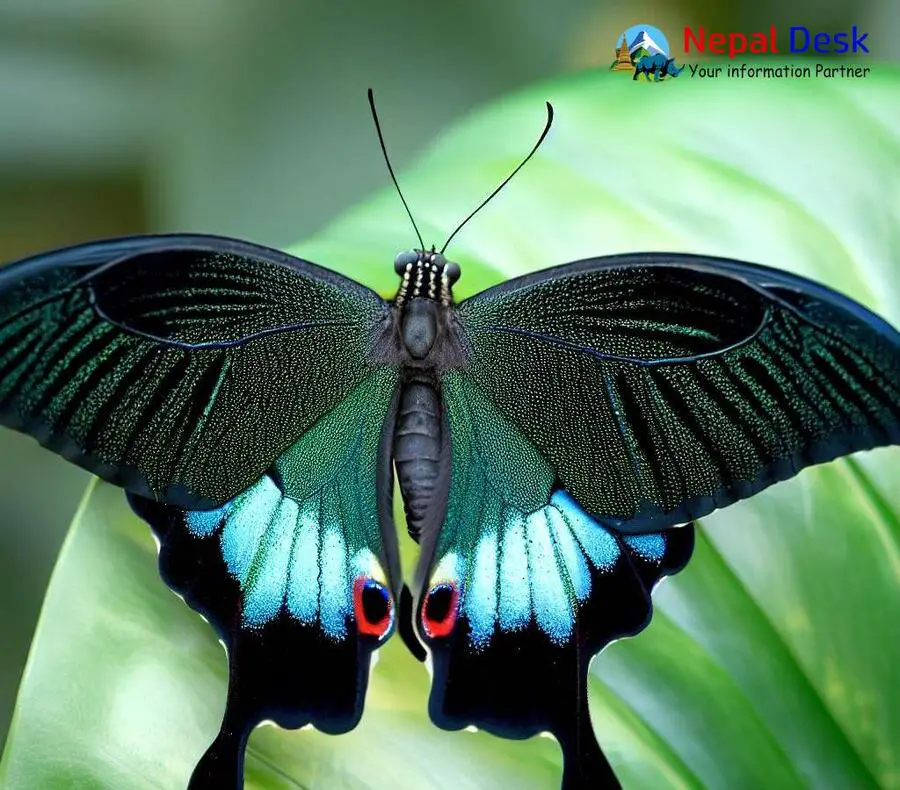
The Paris Peacock, a member of the Papilionidae family, is native to the South and certain regions of Southeast Asia. These butterflies display sexual dimorphism, with males donning a vivid blue sheen on their wings, while females exhibit shades of green. Their lower wing sections feature eye-catching eye-spot patterns, creating an illusion of larger eyes that deter predators. Not only are these butterflies visually captivating, but they also play a pivotal role in pollinating their local ecosystems.
Habitat of The Paris Peacock Butterfly
Paris Peacocks adapt to various habitats, including dense tropical forests and open woodlands. They can endure different elevations, ranging from low-lying areas to heights of up to 2,000 meters above sea level. Typically, they inhabit regions abundant in their favored host plants like citrus trees and those from the Rutaceae family.
Lifecycle of The Paris Peacock Butterfly
The lifecycle of Paris Peacocks consists of four stages: egg, larva (caterpillar), pupa (chrysalis), and adult. Females lay their eggs on soft leaves or host plant stems; within 4-5 days, these eggs hatch into caterpillars. Displaying unique greenish-blue and white saddle patterns, the caterpillars grow through several molting processes.
Upon reaching its maximum size, the caterpillar creates a chrysalis under a leaf or twig to transform into an adult butterfly. This pupation stage lasts anywhere from two to three weeks, depending on environmental conditions. Once emerged from the chrysalis, adult Paris Peacocks live for several weeks while feeding on nectar-rich flowers and engaging in mating behaviors.
Discover The Paris Peacock Butterfly in Nepal
These stunning butterflies are mostly seen throughout South Asia–from India and Sri Lanka to China and Vietnam. In Nepal, their distribution is quite widespread as they grace the Terai landscapes and extend up to the mid-hills, particularly in Chitwan National Park.
To summarize, the Paris Peacock butterfly epitomizes nature's beauty and diversity. As you explore Nepal's lush forests or stroll through scenic woodlands, keep an eye out for these exquisite creatures as they enchantingly flutter by.
Male Paris Peacock Butterfly : Physical Features and Behaviour
Male Paris Peacock butterflies are striking in their vibrant colors and sizable wingspans of about 60mm. Their deep blue-green upper wing side features purple and red spots at the base, while the brown lower side displays light-colored spots and a distinct eyespot. Males possess a slightly larger wingspan than females and exhibit more intense coloration.
Male Paris Peacocks mate multiple times throughout their lives, chasing females across long distances in search of a suitable partner. Most active during warmer months, males can be seen flying in sunlit areas like fields and meadows. They feed on nectar from various flowers, playing a crucial role as pollinators within their habitats.
Female Paris Peacock Butterfly : Physical Features and Behaviour
Female Paris Peacock butterflies are recognized for their stunning physical attributes and unusual behaviors. With vibrant blue wings adorned with colorful eye spots, these butterflies are particularly abundant in the Mediterranean region where they dance among sun-soaked landscapes.
Regarding behavior, female Paris Peacocks are truly intriguing creatures. For instance, their bright wing colors serve as aposematism or warning display since they are poisonous to predators; the eye spots also act as deterrents against possible attacks. Additionally, females indulge in an uncommon behavior called mud-puddling–landing on wet soil to sip minerals and salts from the mud which helps produce healthy eggs when it comes to reproductive fitness.
Flight Pattern and Behaviour of The Paris Peacock Butterfly
The Paris Peacock Butterfly flies very effectively due to its lightweight body. Weighing merely a few grams, it effortlessly takes flight. Its wings are also impeccably designed for flight, with a distinct shape and size that provide optimal lift and maneuverability. These butterflies possess extraordinary vision and can swiftly adjust to alterations in wind speed and direction. They are also skilled at evading obstacles and predators by utilizing their agility and swiftness to stay ahead.
Young Paris Peacock Butterflies dedicate much of their time to refining their flying abilities, progressively developing the strength and control required for expert flying. With determination and time, they can glide through the air effortlessly, showcasing their beauty for any fortunate onlooker.
The flight of the Paris Peacock Butterfly is an astonishing sight to behold. By employing a lightweight body, impeccable wing design, and sharp environmental awareness, these butterflies can accurately and gracefully traverse the sky. Anyone intrigued by the science of flight would certainly find the Paris Peacock Butterfly worth examining.
Conclusion
To sum up, the Paris Peacock Butterfly (Aglais io) is a beautiful species recognized for its striking patterns and elegant flight. However, this butterfly faces challenges due to habitat loss and climate change, emphasizing the pressing need for conservation initiatives and sustainable practices to protect this emblematic species and its delicate ecosystem. By preserving their habitat and fostering biodiversity, we can ensure the continued existence of this captivating butterfly, allowing future generations to marvel at its beauty and cherish its presence.
